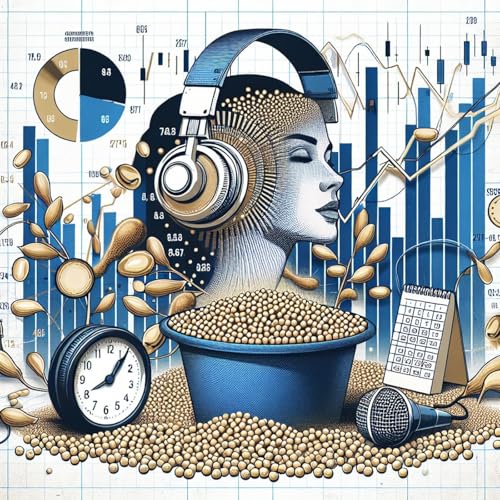
Soybean Surge: U.S.-China Trade Talks Fuel Optimism
Failed to add items
Sorry, we are unable to add the item because your shopping cart is already at capacity.
Add to basket failed.
Please try again later
Add to Wish List failed.
Please try again later
Remove from Wish List failed.
Please try again later
Follow podcast failed
Unfollow podcast failed
-
Narrated by:
-
By:
About this listen
This is your Daily Soybeans Price Tracker with Vanessa Clark podcast.
Welcome back to the Daily Soybeans Price Tracker. I am Vanessa Clark, and as always, I am here to bring you all the essential updates on soybeans, the global commodity that is always in the headlines and on the minds of farmers, traders, and anyone whose morning runs on that soy milk latte.
Let’s get straight to what everyone wants to know: the current trading price for soybeans. Monday’s session saw soybeans for November delivery closing at ten dollars and sixty-seven and a quarter cents per bushel on the Chicago Board of Trade. That is a solid two point four percent jump for the day, as reported by Morningstar.
What’s driving this rally? It is all about the recent buzz from last weekend’s trade talks between the United States and China. Treasury Secretary Scott Bessent announced that China is expected to significantly ramp up its purchases of U S soybeans. The timing couldn’t be more important, with in-person meetings between the U S and Chinese leaders happening later this week. According to ADM Investor Services, a potential deal has taken the threat of a one hundred percent Chinese tariff off the table for now, giving the market a shot of optimism and pushing prices higher right out of the gate on Sunday evening.
Now, if you are following soybean futures, this moment feels like a big turnaround after months of sluggish prices and plenty of nerves about oversupply. U S farmers have been storing away as much of the crop as possible. With tight supplies in the pipeline, processors are raising their bids, especially for soybean meal, which has rallied for nine sessions in a row. This is a direct result of those bullish trade headlines that suddenly made soybeans the star of the commodity world again.
There is another piece to this puzzle: global competition. Even as the U S is celebrating a potential lift in Chinese demand, analysts point out that Brazil is planting even more soybeans this year, trying to grab a bigger piece of the international market. So, while a trade deal is great news for U S growers, there is still a lot of global supply out there.
Turning to practical tips, if you are a soybean producer or thinking about locking in prices, these kinds of trade developments and competitive dynamics highlight how important it is to stay nimble. Watch the big global headlines, but do not lose sight of the fundamentals: local prices, input costs, and your marketing strategy.
Before I wrap things up, I want to address one more update from the U S Department of Agriculture. Export inspections have been down compared to a year ago, with last week’s total at just over one million metric tons, which is a reminder that despite the falling tariffs and trade excitement, strong export movement is still the key driver for sustainable price gains.
That’s your Daily Soybeans Price Tracker for today. I am Vanessa Clark, and I want to thank you for joining me and tuning in for another round of the latest news and insights on soybeans. If you want the freshest commodity updates delivered right to your favorite podcast feed, be sure to hit subscribe and tune in next time. Thank you for listening, and here is to another productive week ahead.
For more http://www.quietplease.ai
Check out Vanessa on Instagram https://www.instagram.com/vanessaclarkipai
For some deals, check out
https://amzn.to/4hSgB4r
This content was created in partnership and with the help of Artificial Intelligence AI
No reviews yet
In the spirit of reconciliation, Audible acknowledges the Traditional Custodians of country throughout Australia and their connections to land, sea and community. We pay our respect to their elders past and present and extend that respect to all Aboriginal and Torres Strait Islander peoples today.



